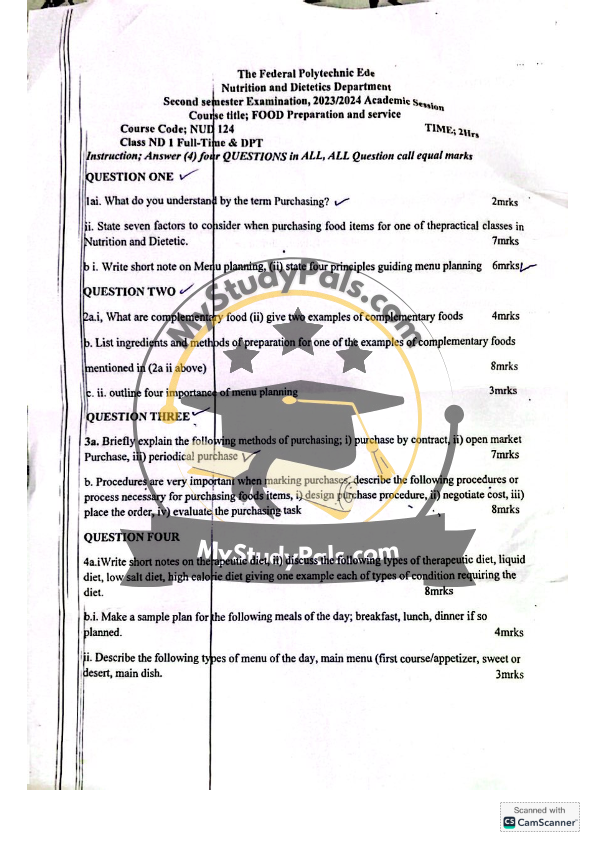ANSWER
Question 1
a.i. What do you understand by the term Purchasing?
Purchasing refers to the process of acquiring goods or services by selecting suppliers, negotiating prices, and completing transactions to meet specific needs. In food preparation and service, it involves buying food items and ingredients in the right quantity, quality, and cost to ensure smooth operations.
a.ii. State seven factors to consider when purchasing food items for one of the practical classes in Nutrition and Dietetics.
- Quality of the food items – Ensure they meet required standards and are fresh.
- Nutritional value – Select food items that provide the necessary nutrients.
- Cost and budget – Purchase items that fit within the allocated budget.
- Availability of the food items – Ensure they are in stock or can be sourced easily.
- Storage and preservation – Consider whether the food can be stored properly.
- Quantity required – Buy enough to meet the class requirements without wastage.
- Supplier reliability – Choose trusted suppliers who provide quality and timely delivery.
b.i. Write a short note on menu planning.
Menu planning is the process of designing meal options that are nutritionally balanced, cost-effective, and appealing to consumers. It involves selecting food items based on dietary requirements, available resources, and customer preferences while ensuring variety and proper meal combinations.
b.ii. State four principles guiding menu planning.
- Balanced Nutrition – Ensure meals include essential nutrients in the right proportions.
- Variety and Appeal – Include different textures, colors, and flavors to make meals enjoyable.
- Cost-effectiveness – Plan menus within budget while maintaining quality.
- Availability of Ingredients – Choose ingredients that are in season or readily available.
Question 2
a.i. What are complementary foods?
Complementary foods are additional foods introduced to infants alongside breast milk to meet their growing nutritional needs. These foods help provide essential nutrients that breast milk alone may no longer supply in adequate amounts.
a.ii. Give two examples of complementary foods.
- Mashed fruits (e.g., banana, avocado, papaya)
- Fortified cereal porridge (e.g., maize porridge, rice cereal)
b. List ingredients and methods of preparation for one of the examples of complementary foods mentioned in (2a.ii) above.
Example: Fortified Cereal Porridge
Ingredients:
- 1 cup maize flour or rice flour
- 2 cups water
- 1 teaspoon vegetable oil or butter
- 1 teaspoon sugar (optional)
- Milk or mashed fruit for extra nutrition
Method of Preparation:
- Boil water in a pot.
- Gradually add maize or rice flour while stirring to prevent lumps.
- Cook on low heat for about 10-15 minutes, stirring continuously.
- Add a little oil or butter for energy and better texture.
- Optionally, mix in mashed fruit or milk before serving.
c. Outline four importance of menu planning.
- Ensures Nutritional Balance – Provides a variety of nutrients in meals.
- Cost Control – Helps manage food expenses efficiently.
- Reduces Waste – Prevents over-purchasing and food spoilage.
- Saves Time and Effort – Streamlines cooking and ingredient preparation.
Question 3
a. Briefly explain the following methods of purchasing:
- Purchase by contract – Buying food items through a pre-agreed contract with a supplier for a fixed period, ensuring consistent supply and stable pricing.
- Open market purchase – Buying food directly from markets or vendors based on availability, often leading to price fluctuations.
- Periodical purchase – Buying food at regular intervals, such as weekly or monthly, to maintain stock levels while ensuring freshness.
b. Describe the following procedures necessary for purchasing food items:
- Design purchase procedure – Establish clear guidelines for selecting and buying food, including quality standards, supplier selection, and budget considerations.
- Negotiate cost – Discuss prices with suppliers to obtain the best value while maintaining quality.
- Place the order – Submit a purchase request specifying quantity, quality, and delivery details.
- Evaluate the purchasing task – Assess the effectiveness of the purchase by checking if the food meets quality and cost expectations.
Question 4
a.i. Write short notes on therapeutic diet.
A therapeutic diet is a meal plan designed to help manage medical conditions. It involves modifying food intake based on an individual’s health needs, such as reducing or increasing certain nutrients.
a.ii. Discuss the following types of therapeutic diets, giving one example of a condition requiring each diet:
- Liquid Diet – Consists of clear or full liquids, often used for patients recovering from surgery or digestive issues.
- Example: A patient with gastrointestinal obstruction.
- Low Salt Diet – Limits sodium intake to prevent fluid retention and high blood pressure.
- Example: A patient with hypertension.
- High-Calorie Diet – Includes energy-dense foods to support weight gain or high energy needs.
- Example: A patient with malnutrition or recovering from severe illness.
b.i. Make a sample plan for the following meals of the day: breakfast, lunch, and dinner.
- Breakfast: Oatmeal with milk and honey, scrambled eggs, fresh fruit juice.
- Lunch: Grilled chicken with brown rice and steamed vegetables, yogurt.
- Dinner: Fish stew with boiled plantains and a side salad.
b.ii. Describe the following types of menus:
- Main Menu – The primary menu offered in a restaurant or cafeteria, listing the main meal options available.
- First Course/Appetizer – A small dish served before the main meal, such as soup or salad.
- Sweet or Dessert – A dish served at the end of a meal, like cake, pudding, or fruit.
- Main Dish – The central part of a meal, usually containing a protein source like meat, fish, or beans.


